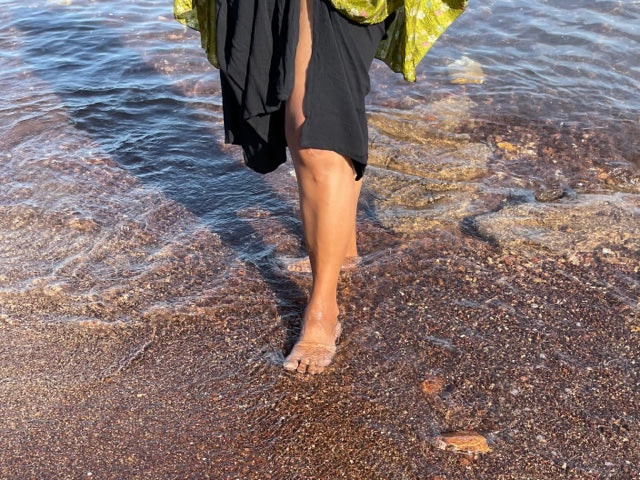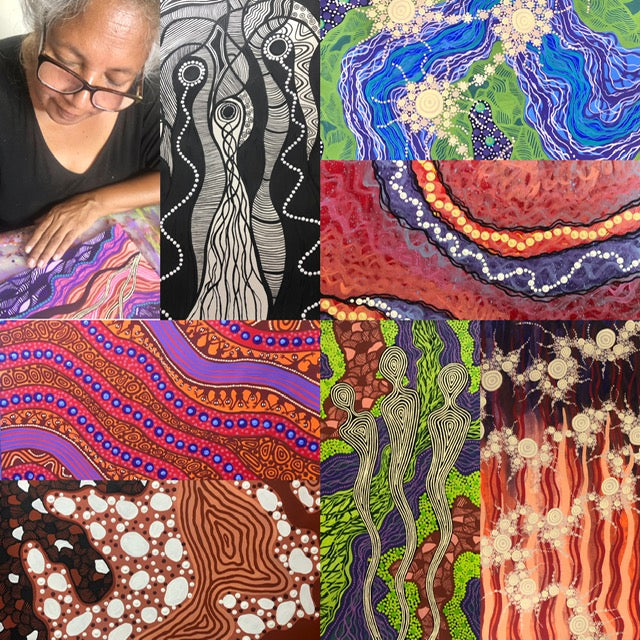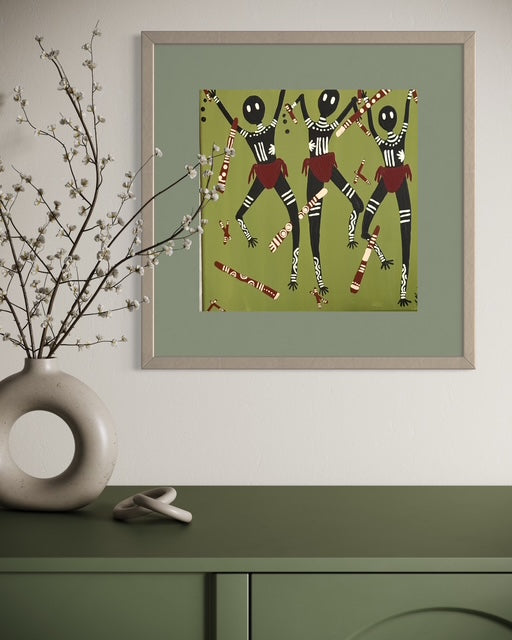
Joanne Nasir Art rich in culture and ancestor’s stories.

Acknowledgement
I acknowledge the Larrakia people the Traditional Owners of the land that I was born, raised and live on. I love my beautiful Darwin so it is with gratitude that I pay my respects to the Larrakia people their Elders and emerging leaders of past, present and future. I am grateful for the collaboration with Larrakia and all the Aboriginal and/or Torres Strait Island people of Darwin, Northern Territory and Australia.
I acknowledge all custodians and traditional owners of their lands, people and cultures within Australia. I pay my respects to all your Elders and emerging leaders of past, present and future.
May we all share and continue to grow with the strength, spirituality and resilience from our lands, people and culture.

Share My Journey
I'm excited that your visiting my shop. I hope you find a painting, print or product that connects with you.
Prints and merchandise are from my original paintings.
Having Aboriginal artwork in your home or office, you open up conversations and opportunities to share the rich stories and traditions of the Indigenous people of Australia.
Buy direct from Artist. Help me to keep my art and culture alive.
Instagram Followers about my artwork ...
-
@ishtar.byronbay
Absolutely beautiful.
-
@ashleighanne.artist
Beautiful @joannenasirartanddesign love the colours!
-
@bowlingandlifestylemagazine
Love it.
-
@flora_kitty_design
Beautiful as always
-
@havagurevichart
I just love these!! Love the colours and lines.
-
@sistagurlrising
Love this auntie ... I totally feel the same, art has so much healing. xo
Featured products
-
A Land of Many Colours
Regular price $200.00 AUDRegular price -
A Land of Many Colours 2
Regular price $200.00 AUDRegular price -
A Land of Many Colours 4
Regular price $200.00 AUDRegular price -
Making Music
Regular price $200.00 AUDRegular price
FAQs
What inspired you to become an artist?
I’ve always loved art from a very young age. My father’s family were creative. His mother was an avid shell collector and Aboriginal businesswomen from Broome Western Australia and then in the 60’s they moved to Darwin. She painted shells and landscape paintings. My mother her people from the Northern
Territory had strong cultural connections to their stories and land. In my early years these two aspects prompted my self-discovery learning journey and I
wanted to know more and record more. This sparked me into exploring how I could do this for my family and self. Now years on I have continued with doing art
but it’s now for my family, children and their children to know, understand and
grow about our family, our histories and stories through my paintings. This is my legacy, my way of contributing and giving to my family, culture and people.
How do you incorporate your cultural heritage into your artwork?
I had to seek permission from my Elder’s on my mother’s side
from Borroloola, Garrawa Language Group. I was fortunate that back in the 90s Senior
Elders were still alive and I had the privilege over many years to work in Borroloola which also gave me connection and access to them, my stories and supported me in creating imagery to fit very important cultural stories. This foundational work was and still is pivotal in what I paint and how I portray
the stories within my paintings, even today. I merge Borroloola imagery with all my paintings. I do Stolen Generations family history, Aboriginal people
connections and concerns, Broome stories and lands, and figures and animals all imagery that I have created over my lifetime.
I paint five Songlines or Dreamings of my Ancestors: Stone Dreaming, Nygabaya or Spirit People Dreaming, Moon Dreaming, Fire Dreaming and
Stranger Serpent Dreaming. My totems are Saltwater Crocodile, Green Sea Turtle, Brolga, Dugong and Osprey.
What materials do you use to create your artwork?
I am an Aboriginal contemporary artist so I love painting on
paper, recycled paper, recycled jars and pots and canvas. My best medium is acrylic and in recent years I am loving working with Jo Sonja acrylic paints.
How do you connect with your community through your artwork?
I love that over the past twenty or so years I’ve had the good opportunity to bring my own people to view, purchase and appreciate my artwork.
What role do you think art plays in preserving Aboriginal culture?
I know with the stories that my artwork depict some old people in the 90s knew these stories and they had told me that they were old
Dreamings that may have been forgotten or possibly lost. Many people cry, emotional and hug me through their tears for doing my paintings recording culture and stories of family
or Stolen Generations history.
Can you explain the meaning behind your artwork?
There are a range of different meanings behind various pieces of my artwork. Generally, it really is dependant in what I story I want to portray in the painting. I tend to do paintings that raise people’s interest and curiosity about aboriginal people and our issues but don’t have opportunity to talk and further understand us. I do paintings that stimulate conversation and can draw the viewer into sometimes sensitive and difficult matters through a visual medium that may gently that may gently support their further understanding of Indigenous people, their stories, history, culture and life.
Have you faced any challenges as an Aboriginal artist, and how have you overcome them?
For many years I have struggled for recognition and acknowledgement as an artist. Not giving up and having a good support network around me has been crucial. Not having money or financial independence. Social
exclusion, marginalisation and racism are impacting factors, but they only made me more determined. It has been a hard road for many years but with effort, consistency, persistence and discipline I am slowly reaping connections with further understanding from my Aboriginal community and wider community of my artwork.
How do you see your artwork evolving in the future?
I notice changes now. I’m influenced by the world that
surrounds me and the concerns people face either individually, within families and communities and societies. I listen and portray imagery through my eyes and
my interpretation in the hope of creating positive change. I’m all about making life better. Whatever small contribution I can make I’ll keep on doing what I
do as an Aboriginal artist.
How do you balance the traditional and contemporary aspects of your artwork?
For me living here in Darwin with family connected to remote
Aboriginal regions coming and visiting and not being far away it’s been easy, familiar and comforting. Also I’m one of those strange people that look at the
person and listen to their stories first and foremost as this can be a wonderful work on canvas. So my traditions from a cultural perspective are entwined and
ingrained in me as a person. If I didn’t walk with this I think my mum who I live with will certainly tell me in no uncertain terms, “that I didn’t fall out of the sky, remember who you are and who you come from.”
What advice would you give to aspiring Aboriginal artists?
I tell people it’s a great because your get to record and restore history and culture. It is needed. However, I caution them. It is hard and most people won’t understand as it is not necessarily a career, but a vocation and you may not be able to survive on an artist wage. Get some qualification you can do to earn money and get a cash flow. As artwork and being an Aboriginal artist is expensive. It is not a hobby. It is your investment in self and your people and it will be your life’s work.
How long have you been creating aboriginal art?
Since 1987 and I had my first solo exhibition in 1989 a very long time.
What is the significance of the symbols in your artwork?
My imagery is connected to Garrawa (Borroloola NT) my Ancestor’s stories where I apply my interpretations, where I use a cream circle or dot with three inner circle and dots connected to represent the Stone Dreaming. Then there are the Spirit People and imagery connected to the Spirit People Dreaming. Fire imagery connected to Fire Dreaming and the moon connected to Moon Dreaming and the Rainbow Serpents connected to the Stranger Serpent Dreaming. Also, my animals for my totems and a variety of figures that I am known for creating and including in my paintings representing Aboriginal people, our lives and stories.
How do you see your art contributing to the preservation of Aboriginal culture?
I believe my artwork contributes to the preservation and restoration of my family, people and communities and Aboriginal culture. I keep the stories and culture alive and share to others either Aboriginal and/or Torres Strait Islander people or other people of different cultures and other Australians.
Can you tell us about any upcoming exhibitions or projects?
Joanne Nasir and Tanyah Nasir Consulting Services will present a community static display titled, Tracy's Echo: 50 Years of Resilience Aboriginal Seniors Memories and Stories from Nov 2024 to January 2025 at the Darwin Airport Terminal.
If your in town pop in and view the artworks.
Collapsible row
Do you do commissions?
Yes. I can do small and large commissions. Four spaces a year for commissions.
Joanne Nasir Art merchandise is printed by other suppliers.
All my merchandise is listed under my business name of Joanne Nasir Art.
Please note, I do not have any stock on hand except my original paintings and/or prints on cotton rag paper. Limited Edition prints are printed in Darwin.
All my merchandise from cups, blankets and Tees are printed and shipped by my production partner Printify. They are quality printers from US-based manufacturer of print on demand.
Merchandise in Australia may take up to 4 weeks and 6 to 8 weeks internationally.
You can always reach out to myself to check.
Refund Policy
Joanne Nasir Art does not refund on painting and/or prints. Unless there has been damage to the print colour. Note there is a 30 day refund policy. No refund on purchase but you can get credit for another item to the same value.





